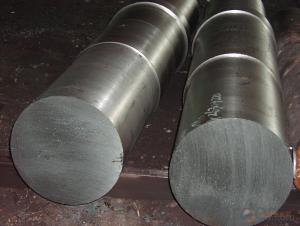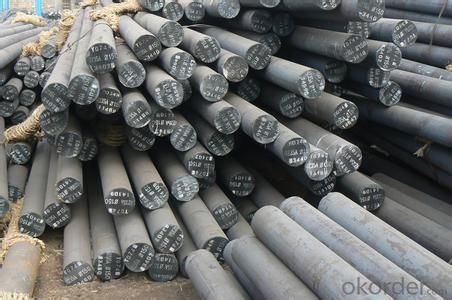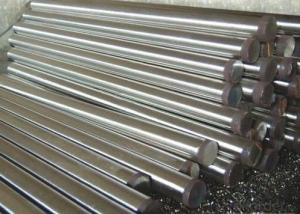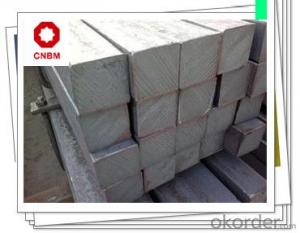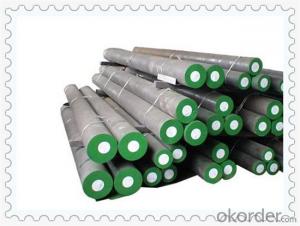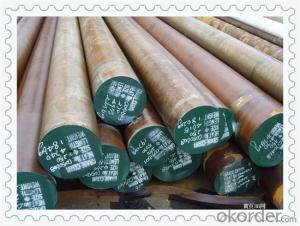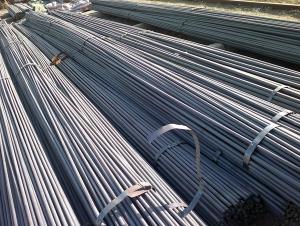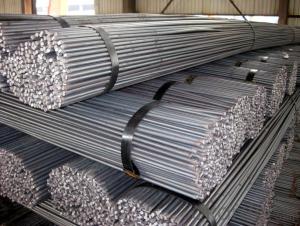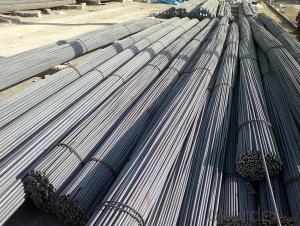Alloyed steel round bar
- Loading Port:
- China Main Port
- Payment Terms:
- TT OR LC
- Min Order Qty:
- -
- Supply Capability:
- -
OKorder Service Pledge
Quality Product, Order Online Tracking, Timely Delivery
OKorder Financial Service
Credit Rating, Credit Services, Credit Purchasing
You Might Also Like
Quick Details
| Steel Grade: | Standard: | Dimensions: | |||
| Place of Origin: | Brand Name: | Model Number: | |||
| Technique: | Application: | Alloy Or Not: | |||
| Special Use: | Type: | LENGTH: | |||
| COMMODITY: | SPEC: | SIZE: |
Packaging & Delivery
| Packaging Detail: | Packing Term: Bulk Packing Or Container. |
| Delivery Detail: | Within 30-45 days as of the date of contract signing |
Specifications
ROUND BAR (S45C,S20C,SS400,A36)
1.Length:6m to 12m
2.Grade:Q235/SS400/S20C/S45C
Remarks:
1.Origin / Manufacturer: China
2.Port of Loading: Tianjin Port,China
3.Packing Term: Bulk Packing Or Container
4.Measurement of Weight: By Theoretical Weighting
5.Certificate:ISO9001,CIC,BV,SGS
- Q: Are steel round bars susceptible to cracking?
- Cracking in steel round bars can occur under certain circumstances. Factors that contribute to cracking include high stress levels, improper heat treatment, and the presence of impurities or defects in the material. Cracking is also more likely with sudden temperature changes or excessive loading. It is worth noting that the susceptibility to cracking varies depending on the grade and composition of the steel. Low carbon or mild steel is generally less prone to cracking compared to higher carbon or alloy steels. To prevent cracking, it is crucial to handle and store steel round bars properly. This includes avoiding dropping or mishandling the bars and storing them in a dry, controlled environment to prevent corrosion. Proper heat treatment processes, such as annealing or tempering, can improve the structural integrity of steel round bars and reduce the risk of cracking. Regular inspections and testing for defects or impurities can help identify and address issues before they lead to cracking. In conclusion, while steel round bars can be susceptible to cracking, taking appropriate precautions and using proper manufacturing and handling techniques can minimize the risk and ensure the bars' integrity.
- Q: The difference between 304 stainless steel round bar and bright round bar
- Stainless steel rounds are not required on the surface. They may come with black leather. They may be pickling surfaces or cold drawn or polished surfaces;Stainless steel bright round steel refers to polished surface or cold drawn surface round steel.304 is the brand, and the surface quality has nothing to do with.
- Q: What are the different methods of cutting steel round bars?
- Cutting steel round bars can be achieved through several methods, each with their own advantages and limitations. Among the commonly utilized techniques are: 1. Abrasive cutting: By utilizing a rotating abrasive wheel, the steel round bar can be ground down. Despite its speed and efficiency, this method often results in a rough cut surface and generates significant heat. 2. Bandsaw cutting: Steel round bars can be sliced using bandsaw machines, which feature a continuous band of toothed metal rotating around two wheels. Although bandsaws provide precise and smooth cuts, they tend to be slower compared to alternative methods. 3. Cold saw cutting: Cold saws are designed specifically for cutting metal, including steel round bars. These saws employ circular blades with teeth that are specially crafted to withstand the hardness of steel. While cold saws guarantee clean and accurate cuts, they generally operate at a slower pace than abrasive or bandsaw cutting. 4. Plasma cutting: Ideal for thicker steel round bars, plasma cutting involves using a focused jet of ionized gas to melt and remove the metal. This method yields precise and clean cuts, but necessitates specialized equipment and can be more costly than other techniques. 5. Laser cutting: Laser cutting employs a high-powered laser beam to melt and vaporize the metal, resulting in precise and clean cuts. This versatile method can be utilized for steel round bars of varying thicknesses, but it does require expensive equipment and may not be suitable for all applications. Ultimately, the chosen cutting method relies on several factors, including the thickness and hardness of the steel round bar, the desired cut quality, the availability of equipment, and the specific project requirements.
- Q: How do you calculate the weight of a steel round bar based on its volume and density?
- To calculate the weight of a steel round bar based on its volume and density, you can use the formula: weight = volume x density.
- Q: Are steel round bars suitable for welding applications?
- Yes, steel round bars are suitable for welding applications. Steel is a commonly used material in welding due to its high strength and durability. Round bars have a consistent shape and provide good stability and support during the welding process. They can be easily welded using various methods such as MIG, TIG, or stick welding, making them ideal for a wide range of welding applications in industries like construction, manufacturing, and automotive.
- Q: What are the different types of tests performed on steel round bars for quality control?
- There are several types of tests performed on steel round bars for quality control purposes. These tests help to ensure that the steel bars meet the required standards and specifications. Some of the common tests conducted on steel round bars include: 1. Tensile Test: This test evaluates the tensile strength, yield strength, and elongation properties of the steel bars. It involves applying a pulling force to the bar until it breaks, measuring the maximum force the bar can withstand, and determining the bar's ability to stretch without fracturing. 2. Hardness Test: The hardness test measures the resistance of the steel bar to indentation or scratching. It provides an indication of the bar's strength and durability. Common hardness tests include Rockwell, Brinell, and Vickers tests. 3. Chemical Composition Analysis: This test determines the chemical composition of the steel round bars, including the percentage of various elements such as carbon, manganese, sulfur, phosphorus, and others. It ensures that the bars meet the specified chemical composition requirements. 4. Ultrasonic Testing: Ultrasonic testing uses high-frequency sound waves to detect any internal defects or discontinuities within the steel bars. This non-destructive test helps identify cracks, voids, or other defects that may affect the bar's structural integrity. 5. Dimensional Inspection: This test ensures that the steel round bars meet the required dimensional tolerances, including diameter, length, and straightness. It involves using precision measuring instruments such as calipers, micrometers, and gauges to verify the bar's dimensions. 6. Surface Quality Examination: This test inspects the surface condition of the steel bars for any defects, such as cracks, pits, scratches, or other surface irregularities. It is crucial to ensure that the bars have a smooth and defect-free surface for proper functionality and safety. 7. Microstructure Analysis: Microstructure analysis involves examining the steel bar's internal structure under a microscope. It helps determine the grain size, inclusion content, and overall microstructural integrity of the bars. This analysis provides insights into the bars' mechanical properties and their ability to withstand various loads and stresses. By performing these tests, manufacturers can ensure that the steel round bars meet the required quality standards and are suitable for their intended applications.
- Q: What are the different types of surface defects in steel round bars?
- Steel round bars can have different types of surface defects, which can vary in severity and affect the quality and performance of the bars. Common surface defects include: 1. Scale: During manufacturing, an oxide layer called scale can form on the surface of the steel. Scale appears as a rough, flaky layer and negatively affects the bar's appearance and surface finish. 2. Pits: Small depressions or cavities can occur on the bar's surface due to corrosion, mechanical damage, or manufacturing defects. Pits weaken the bar's structural integrity and increase the risk of failure. 3. Scratches: Shallow grooves or marks can be caused by handling, transportation, or contact with other objects during manufacturing. While scratches may not significantly impact the bar's strength, they do affect its appearance and surface finish. 4. Cracks: Linear fractures on the bar's surface can result from excessive stress, thermal cycling, or manufacturing defects. Cracks are extremely harmful to the bar's strength and integrity and can lead to catastrophic failure if not addressed. 5. Decarburization: Loss of carbon from the steel bar's surface layer, which can occur during heating or cooling processes. This process results in a softer and weaker surface layer, reducing the bar's overall strength and durability. 6. Lamination: Separation or delamination of layers within the steel bar, caused by improper bonding or rolling conditions during manufacturing. Lamination weakens the bar's structural integrity and increases the likelihood of failure. 7. Inclusions: Non-metallic particles or impurities present on the bar's surface, caused by contaminants in raw materials or improper manufacturing processes. Inclusions negatively impact the bar's mechanical properties and performance. To ensure the quality and performance of steel round bars, it is crucial to identify and address these surface defects. Various inspection and testing methods can be used, such as visual inspection, ultrasonic testing, magnetic particle inspection, and dye penetrant inspection.
- Q: How do steel round bars perform under torsion or twisting forces?
- The exceptional performance of steel round bars in resisting torsion or twisting forces is widely recognized. Thanks to their inherent strength and stiffness, steel round bars can endure high levels of torque without experiencing significant deformation or failure. When subjected to torsion, steel round bars display what is known as elastic behavior. Initially, the bar will twist and deform elastically, meaning it will revert to its original shape once the twisting forces are no longer applied. This elastic deformation is directly proportional to the magnitude of the applied torque, in accordance with Hooke's law. However, if the torsional forces surpass the elastic limit of the steel round bar, it will undergo plastic deformation. This entails the permanent twisting of the bar, preventing it from returning to its original shape after the forces are released. The extent of plastic deformation depends on the magnitude and duration of the torsional forces. The high tensile strength of steel round bars makes them highly resistant to torsional failure, enabling them to withstand substantial twisting forces. Moreover, the round bars' smooth and uniform surface reduces the likelihood of stress concentrations, further enhancing their torsional performance. It is crucial to note that the torsional performance of steel round bars can be influenced by various factors, such as alloy composition, heat treatment, and manufacturing processes. By carefully selecting appropriate steel grades and employing suitable processing techniques, the torsional strength and performance of steel round bars can be further optimized to meet specific application requirements.
- Q: Can steel round bars be used in the manufacturing of kitchenware?
- Yes, steel round bars can be used in the manufacturing of kitchenware. Steel is a durable and versatile material that is commonly used in the production of kitchen utensils and cookware. Steel round bars can be shaped and molded into various kitchenware items such as pots, pans, knives, spoons, and forks. The strength and heat resistance of steel make it suitable for cooking and food preparation purposes. Additionally, steel is easy to clean, hygienic, and resistant to corrosion, making it ideal for use in kitchenware.
- Q: Can steel round bars be used for making gears or sprockets?
- Yes, steel round bars can be used for making gears or sprockets. Steel is a commonly used material for gears and sprockets due to its strength, durability, and ability to withstand high loads and friction. The round bars can be machined or shaped into the desired gear or sprocket design, providing a reliable and efficient solution for various applications.
Send your message to us
Alloyed steel round bar
- Loading Port:
- China Main Port
- Payment Terms:
- TT OR LC
- Min Order Qty:
- -
- Supply Capability:
- -
OKorder Service Pledge
Quality Product, Order Online Tracking, Timely Delivery
OKorder Financial Service
Credit Rating, Credit Services, Credit Purchasing
Similar products
Hot products
Hot Searches
Related keywords
